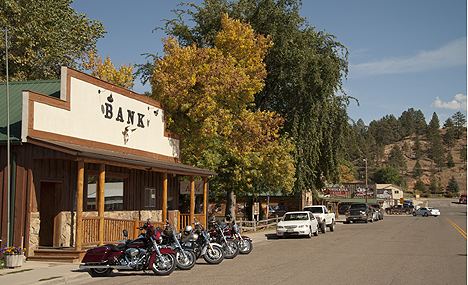Elevation 1,142 m Zip code 82720 Local time Thursday 1:55 AM | Area 225 ha Population 400 (2013) Area code 307 | |
 | ||
Weather 11°C, Wind SW at 11 km/h, 46% Humidity | ||
The Hulett was a design of automatic ore unloader that once saw wide usage along the Great Lakes of North America. They were unsuited to tidewater ports because they could not adjust for rising and falling tides, and few were so used.
Contents
Map of Hulett, WY 82720, USA
History
The Hulett was invented by George Hulett of Ohio in the late 19th century; he received a patent for his invention in 1898. The first working machine was built the following year at Conneaut Harbor in Conneaut, Ohio. It was successful, and many more were built along the Great Lakes, especially the southern shore of Lake Erie to unload boats full of taconite from the iron mines near Lake Superior. Substantial improvements were later made on the design by Samuel T. Wellman. It is these second-generation Huletts which continue to stand to this day.
The Hulett machine revolutionised iron ore shipment on the Great Lakes. Previous methods of unloading lake freighters, involving hoists and buckets and much hand labor, cost approximately 18¢/ton. Unloading with Huletts cost only 5¢/ton. Unloading only took 5–10 hours, as opposed to days for previous methods. Lake boats changed to accommodate the Hulett unloader, and became much larger, doubling in length and quadrupling in capacity.
By 1913, 54 Hulett machines were in service. Two were built at Lake Superior (unloading coal) and five at Gary, Indiana, but the vast majority were along the shores of Lake Erie. The additional unloading capacity they brought helped permit a greater than doubling of the ore traffic in the 1900–1912 period. A total of approximately 75 Huletts were built. One was installed in New York City to unload garbage.
The lake's Huletts were used until about 1992, when self-unloading boats were standard on the American side of the lake. All have since been scrapped. In 1999, only six remained, the group of four at Whiskey Island in Cleveland, Ohio the oldest. Another set was used unloading barges of coal in South Chicago until 2002 and were demolished in the Spring of 2010.
In spite of the Cleveland machines being on the National Register of Historic Places and designated as a Historic Mechanical Engineering Landmark, they were demolished in 2000 by the Cleveland Port Authority to enable development of the underlying land. The Port Authority disassembled and retained two Huletts, to enable their reconstruction at another site, but the reconstruction has not yet happened.
Operation
The electrically powered Hulett unloader rides on two parallel tracks along the docks, one near the edge and one further back, ordinarily with four railroad tracks in between. Steel towers, riding on wheeled trucks, support girders that span the railroad tracks.
Along these girders runs a carriage which can move toward or away from the dock face. This in turn carries a large walking beam which can be raised or lowered; at the dock end of this is a vertical column with a large scoop bucket on the end. A parallel beam is mounted halfway down this column to keep the column vertical as it is raised or lowered. The machine's operator, stationed in the vertical beam above the bucket for maximum cargo visibility, could spin the beam at any angle. The scoop bucket is lowered into the ship's hold, closed to capture a quantity (10 tons approx.) of ore, raised, and moved back toward the dock. The workmen who operate he Hulett uploaders were known as Ore Hogs.
To reduce the required motion of the carriage, a moving receiving hopper runs between the main girders. It is moved to the front for the main bucket to discharge its load, and then moves back to dump it into a waiting railroad car, or out onto a cantilever frame at the back to dump the load onto a stockpile.
The Hulett can move along the dock to align with the holds on an ore boat. When the hold is mostly empty, the Hulett cannot finish the job itself. Workmen entered the hold and shoveled the remaining ore into the Hulett's bucket. More recently, a wheeled excavator would be chained to the Hulett's bucket and lowered into the hold to fill the Hulett.
